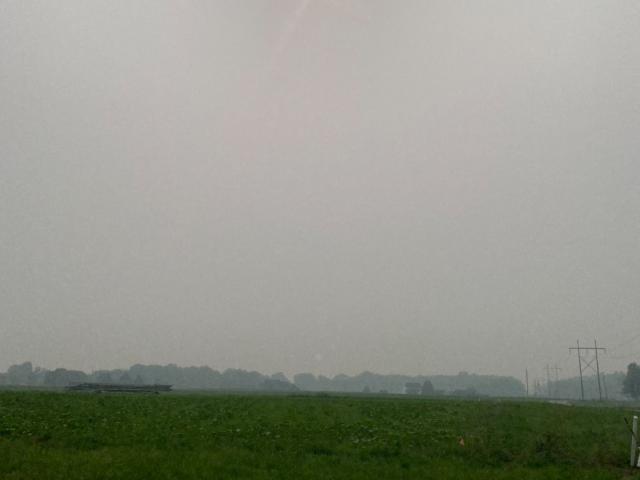
Smoke from Canadian wildfires in 2023 has been prevalent in Ohio this year, and it has come into the state earlier in the season than in past years (like 2021). This condition has the potential to cause harm to plants, but the diffuse light (instead of direct bright sunlight) may help to offset or negate reductions in overall light intensity.
Some of the main concerns related to crops:
Smoke reduces light availability, which could negatively impact photosynthesis in crops (process of converting CO2 into biomass). Reports have shown that reduced light intensity of 15% did not reduce corn yield, though yield losses have been evident when sustained shading (reduced light availability) of 30-50% was imposed.
If present in sufficient quantities near where the plants are growing, gases like ozone can induce plant stress and cause issues in growth and development. Longer exposure could result in greater injury.
The possibility of particulates (e.g., ash residues) depositing onto the tissues themselves, though ash deposition might not be a concern in Ohio. High amounts of wildfire residues on the leaf surface might have the potential to reduce photosynthesis.
The main two crops, corn and soybean, may also have differential responses given they do photosynthesis differently (soybean is a C3 plant that tends to have CO2 be most limiting factor affecting productivity, whereas corn is a C4 plant and tends to have light be the most limiting factor affecting productivity). Reduced sunlight is expected to be more damaging when crops are in the grain fill stages as compared to the vegetative stages where Ohio crops are now. A recommendation is to scout soybean fields that are close to flowering and watch for pod development this season.
For wheat, approaching harvest season, hazy conditions may not favor the drying of grain and could pose favorable conditions for disease development depending on how much haze and for how long.
Some side effects that could lessen the negatives:
Leaf temperatures in the upper canopy are directly correlated to direct sunlight exposure (rather than ambient air temperatures). So, if light is more diffuse it could result in lower leaf surface temperatures. This could be good under water stress/drought conditions, as lower leaf temperatures would reduce the amount of transpiration needed to cool the leaves and could lessen the water stress injury.
Leaf photosynthesis optimizes at light intensities that are 50-67% of full sunlight, and diffuse light can actually help with photosynthesis compared to full direct light.
Looking at the trends in light availability from the CFAES weather stations in Northwestern, Western, Wooster, the dry May and June has led to an accumulated light integral that is greater than the 10-year average through the earlier portion of June (Figure 2). We have seen reduced gains in the total over the last week (end of June), though are trending near the 10-year average.
Another consideration is for how the photothermal quotient (PTQ), or amount of light available per growing degree day, has been trending this season. In June this year, the PTQ values at the three sites mentioned above have been 6-16% greater than normal. In general, a higher PTQ means more photons per GDD, and could lead to greater overall productivity. However, GDD accumulation has been lower this season; tracking crop development this summer will be important.
We will continue to monitor this over the season and will work to provide additional updates.
(This information was originally published in C.O.R.N. Newsletter, which is produced by the Ohio State University Extension Agronomy Team, state specialists at Ohio State University and the Ohio Agricultural Research and Development Center.)









